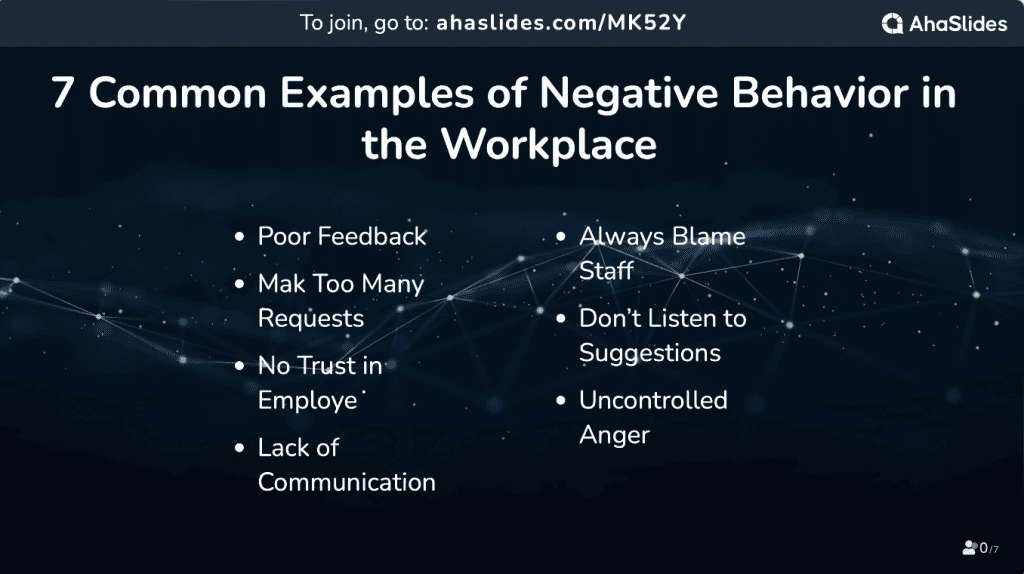My, jako szeregowi pracownicy, codziennie dążymy do osiągania kamieni milowych w karierze i zawsze chcemy dawać z siebie wszystko. Czasami popełniamy błąd i potrzebujemy pomocy i wskazówek od współczujących i kompetentnych menedżerów.
Oczywiście w miejscu pracy częste są przypadki nagany, ostrzeżenia lub nieprzyjemnego spojrzenia ze strony przełożonego. Nawet dobry szef może zachować się zbyt surowo, udzielając nam nagany. Powinieneś jednak nauczyć się zachować ostrożność, jeśli spotkasz się z sytuacjami, w których Twoi przywódcy będą stale mieli złe nastawienie, nawet jeśli dobrze sobie radzisz, nie zauważysz żadnych błędów lub nawet nie przyznasz się do swoich błędów.
Powinieneś przeczytać ten artykuł od razu, jeśli jesteś ciekaw, czy działania twojego lidera są zbyt nie na miejscu. Następujących siedem przykłady negatywnych zachowań w pracy pomoże Ci zidentyfikować toksycznego szefa, zrozumieć, dlaczego tak się stało i szybko działać, aby znaleźć najlepsze rozwiązanie.
Spis treści:
- 7 typowych przykładów negatywnego zachowania w miejscu pracy
- Jak sobie poradzić z negatywnym zachowaniem toksycznego szefa
- Na wynos
- FAQ
Więcej wskazówek od AhaSlides
- Co Twój szef naprawdę myśli o pracy zdalnej
- 7 oznak toksycznego środowiska pracy i najlepsze wskazówki, jak się chronić
- Co to jest zarządzanie stresem | 5 najlepszych praktyk radzenia sobie ze stresem | Ujawnia rok 2024

Zaangażuj swoich pracowników
Rozpocznij znaczącą dyskusję, uzyskaj przydatne informacje zwrotne i edukuj swoich pracowników. Zarejestruj się, aby otrzymać bezpłatny szablon AhaSlides
🚀 Weź darmowy quiz☁️
7 typowych przykładów negatywnego zachowania w miejscu pracy
Jeśli masz dobrego szefa, masz doskonałego nauczyciela. Nikt nie może po prostu spotkać profesjonalnego szefa, który motywuje go do ciężkiej pracy, nauki lub bycia częścią miłego miejsca pracy przez cały czas. To zawsze trudny czas, gdy szef działa agresywnie jako wymówka, aby dbać o pracowników. Możesz pomylić złe interakcje z autentyczną troską. Poznajmy typowe przykłady negatywne zachowanie w miejscu pracy.

Zła informacja zwrotna
Przed omówieniem lub rozwiązaniem problemu pracownicy często zasięgają porady przełożonego. Jeśli odmówią przekazania informacji zwrotnej, ogólnych informacji lub wyrażenia opinii, może dojść do sytuacji, w której Twój szef będzie niekompetentny lub nieodpowiedzialny.
Złóż zbyt wiele żądań
Nieudzielanie, udzielanie małej informacji zwrotnej lub składanie zbyt wielu próśb... to przykłady negatywnego zachowania, które jest niezwykle typowe i powszechne. Szef, który stawia zbyt wiele wymagań, może celowo utrudniać ci życie (lub chcieć, żebyś zrobił to lepiej). Powinieneś dokładnie rozważyć wymagania, aby sprawdzić, czy są one nadmierne i czy mają wpływ na twoje obecne zadania.
Brak zaufania do pracownika
Pracownicy pozbawieni zaufania wykazują nie tylko negatywne cechy osobowości, ale także brak profesjonalizmu i doświadczenia w zarządzaniu ludźmi, mimo że wiedzą, że potrafią sobie z ludźmi poradzić. Oprócz sprzyjania atmosferze braku zaufania ten zły nawyk może uniemożliwiać członkom zespołu kreatywność.
Brak komunikacji
Kolejnym negatywnym przykładem negatywnego zachowania szefa, które może być szkodliwe dla firmy, jest zła komunikacja. To złe zachowanie często objawia się brakiem słuchania lub niemożnością jasnego komunikowania się z innymi członkami zespołu.
Nieskuteczna komunikacja może prowadzić do błędnych wyobrażeń i sprawiać wrażenie, że pracownicy nie są słyszani. Zła komunikacja ze strony przełożonych zmniejsza produktywność i zwiększa stres w pracy.
Zawsze obwiniaj personel
Obwinianie jest jednym z najbardziej znanych przykładów negatywnego zachowania w miejscu pracy. Kultura obwiniania jest często wynikiem nieodpowiednich zdolności przywódczych i komunikacyjnych. Złym szefom będzie trudno stworzyć pozytywne środowisko pracy, jeśli nie będą w stanie przyjąć odpowiedzialności za swoje czyny.
Nie słuchaj sugestii
Twoja opinia, sugestie i obawy nie będą cytowane jako przykłady złego zachowania Twojego szefa. „Żadna organizacja nie może prosperować, jeśli ludzie nie uczą się od siebie nawzajem. W przeciwnym razie wszyscy robimy to samo, co zawsze”
Casciaro, profesor zachowań organizacyjnych i zarządzania zasobami ludzkimi na Uniwersytecie w Toronto, powiedział: „Kiedy szef sprawia, że komunikacja z przełożonymi jest niemal niemożliwa i zgłasza błędy, nie ma rozwoju”. Ponadto możesz czuć, że twoja praca lub pomysły są nieistotne i tracisz ważne okazje do nauki i doskonalenia się, gdy nie możesz komunikować się ze swoim przełożonym.
Niekontrolowany gniew
Wściekły menedżer może zachowywać się krytycznie, rozmawiając z członkami personelu. Gniew nigdy niczego nie rozwiązuje właściwie. Nie pozwól, aby stresujące środowisko pracy twojego menedżera obniżyło twoje morale, zadowolenie z pracy lub motywację.
Jak radzić sobie z negatywnym zachowaniem swojego lidera
Czy zauważyłeś jakieś rozbieżności w swoim zarządzaniu na podstawie kilku przykładów negatywnych zachowań, które omówiliśmy wcześniej? Co możesz zrobić, jeśli odkryjesz, że Twój szef jest toksyczny? Oto kilka porad, jeśli nie masz pewności, jak prawidłowo sobie z tym poradzić.
Przekazuj im konstruktywną informację zwrotną
Niektórzy menedżerowie mogą nie być świadomi szkodliwych skutków tego, co robią. Istnieje wiele przykładów negatywnego zachowania szefów, które ma duży wpływ na niepokój pracowników i odejścia.
Najpierw spróbuj komunikować się z nimi jasno i zwięźle. Może to być również przydatne w ustaleniu, czy styl zarządzania Twojego szefa jest po prostu zły, czy też jest toksyczny — to znaczy niegrzeczny, egoistyczny i zakłócający porządek. spełnia Twoją strefę komfortu.
Zobaczysz, że jeśli ich reakcja na profesjonalną, uprzejmą krytykę będzie bezduszna i nieczuła, przynajmniej będziesz wiedział, z czym masz do czynienia.
⭐️Przeczytaj także: Jak skutecznie udzielać informacji zwrotnej | 12 wskazówek i przykładów (aktualizacje z 2023 r.)
Pielęgnuj samoopiekę
Nigdy nie zapominaj, że tylko Ty możesz zapewnić sobie bezpieczeństwo. Identyfikowanie przypadków szkodliwego zachowania jest sposobem na rozwinięcie samoobrony.
Ponadto zapisuj konkretne przypadki agresywnego zachowania szefa, zbieraj je i umów się z kimś, z kim będziesz mógł omówić swoje obawy, gdy się pojawią. To praktyczna strategia samoobrony. Jest to szczególnie ważne, jeśli ryzykujesz, że szef dowie się, że mówisz o nim negatywnie i będzie chciał się zemścić.
Zapytaj o pomoc
Masz bardzo małą władzę, gdy jesteś zwykłym pracownikiem. Poproś kogoś innego o radę, jak poradzić sobie z sytuacją lub wyjdź, zanim stanie się ona dla ciebie zbyt trudna do opanowania. Może to być twój starszy menedżer (znany również jako szef twojego szefa), pracownik działu kadr lub zaufany doradca. W niektórych przypadkach naprawdę powinna to być osoba spoza miejsca pracy, na przykład gdy twój toksyczny szef jest członkiem większego toksycznego zespołu zarządzającego lub reprezentuje głębszą kultura toksyczna. wykonywać swoje zadania.
⭐️ Przeczytaj także: Opanowanie rozmów jeden na jednego | 5 strategii skutecznej komunikacji w miejscu pracy | Ujawnia rok 2024
Porozmawiaj ze swoimi współpracownikami
Pomyśl o omówieniu tego ze współpracownikiem, jeśli Twój menedżer zachowuje się wobec Ciebie w sposób nieprofesjonalny. Możliwe, że Twój szef traktuje wiele osób w ten sposób lub inni ludzie mogą uważać, że Twój szef traktuje Cię niesprawiedliwie. Mogą również udzielić Ci wnikliwych porad. Może to również pomóc Ci zdecydować, co zrobić dalej, gdy poruszysz tę kwestię ze swoim menedżerem lub działem kadr firmy.
Szukaj nowej pracy
Jeśli poziom Twojego niezadowolenia z pracy nie ulegnie poprawie, powinieneś pomyśleć o zmianie kariery. Przejrzyj swoje CV i poświęć kilka godzin w weekend na przeglądanie ofert pracy i składanie aplikacji na nowe stanowiska.
Zawsze możesz ubiegać się o inną pracę w innym dziale lub oddziale, jeśli pracujesz dla większej firmy. Duża liczba badań wskazuje, że większość ludzi odchodzi od swoich kierowników, a nie od swoich stanowisk. Jeśli chcesz pracować dla nowej firmy i być szczęśliwszym, zdrowszym i bardziej produktywnym, nie ma nic złego w zmianie pracy.
Na wynos
W każdym miejscu pracy są źli szefowie z negatywnymi zachowaniami, ale istnieją strategie radzenia sobie z nimi. Przypomnij sobie, aby nie pozwolić, aby niewygodne lub stresujące sytuacje sprawiły, że staniesz się mniej produktywny w pracy. Nie pozwól, aby zaszło za daleko i znajdź szybkie rozwiązanie. Nawet jeśli jesteś nowym pracownikiem, nikt nie powinien znosić niesprawiedliwego traktowania.
🚀 Dodatkowo współpraca i profesjonalne narzędzia takie jak AhaSlajdy może poprawić komunikację i relacje między szefami i pracownikami.
FAQ
Jak wygląda toksyczny szef?
Cechy, o których mowa, to brak empatii, nadmierna gadatliwość, niekompetencja i fałszywa życzliwość. Legg, który ma 20 lat doświadczenia w korporacyjnym uczeniu się zawodowym, stwierdził, że wielu pracowników „wydaje się pragnąć wszystkich tych cech, nie tylko dlatego, że wydają się nieszkodliwe”.
Czym jest negatywne zachowanie pracowników?
Przykładami negatywnych zachowań są agresja, brak odpowiedzialności, narcyzm, nieuprzejmość, pogarda lub zastraszanie klientów lub współpracowników, słowa lub czyny podważające cele firmy lub ducha zespołowego, a także sprzeciw wobec krytyki lub zmian.
Ref: muza








